Developer commentary
PURKKA: Hello and welcome to our developer commentary! Read on for my thoughts about the process of putting the script together and a breakdown of various mythological & cultural references that not every reader might have caught. There are obviously heavy spoilers, and I won't bother explaining the plot as I go along, so play the VN first unless you really enjoy out-of-context observations.
Let me also preface all this by saying that what I note here is only my authorial intent, not the only way to read the story. I think the fact that different people can get different things from literature is one thing that makes it so interesting, and the ambiguity serves a productive purpose here.
I guess I'll start by going listing some other works that inspired and influenced The Wolf in the Wardrobe. Many remarked on the Narnia connection, and it is indeed there, even if the titular wardrobe and how time works in the secondary world are the only big details I borrowed as-is. I'll also mention Stephen King's and Peter Straub's The Talisman and Black House, from which I got the whole concept of people paralleling each other in the two worlds, and Tomi Kontio's Keväällä isä sai siivet and its sequels with their mix of endearing escapism and insanely dark tone.
As far as FVNs go, there is of course In Case of Emergency, which similarly plays the portal fantasy premise with an undercurrent of existential anxiety. In general, I think there's something inherently unnerving about stories like this – like, I don't know what C.S. Lewis thought he was cooking in the chapter where the Narnia kids return home and are de-aged from their adult selves, but it's absolute cosmic horror, scariest shit I've ever read, and how nonchalantly the plot beat is presented only makes it worse. I tried hard to capture the same vibe of "oh here are the rules of this fantasy world with horrifying implications, don't worry about it :)"
The 1974 movie Penda's Fen was also a loose inspiration, particularly in terms of tone. Besides that, I watched all of Hong Sang-soo's movies not too long ago, and you can probably detect some traces of them here – Ilmari's cyclical arc of denied self-improvement and alienation from other people as a result of sexuality are not too dissimilar to what many of HSS's (male) protagonists go through.
But most importantly, the story riffs on the Kalevala in a lot of ways that are not super subtle. The names of the main characters frame the plot through the creation and the loss of the Sampo – a cornucopia-esque artifact central to some of its most famous episodes – and Ilmari's second name recalls Elias Lönnrot, credited with compiling the epic. I'll talk more about it when we get to the final scene, but this darkly satiric parallel that contrasts developments in the fictional fantasy world with Finnish nationalism's complicated relationship with folklore was the primary thematic angle I approached the story through.
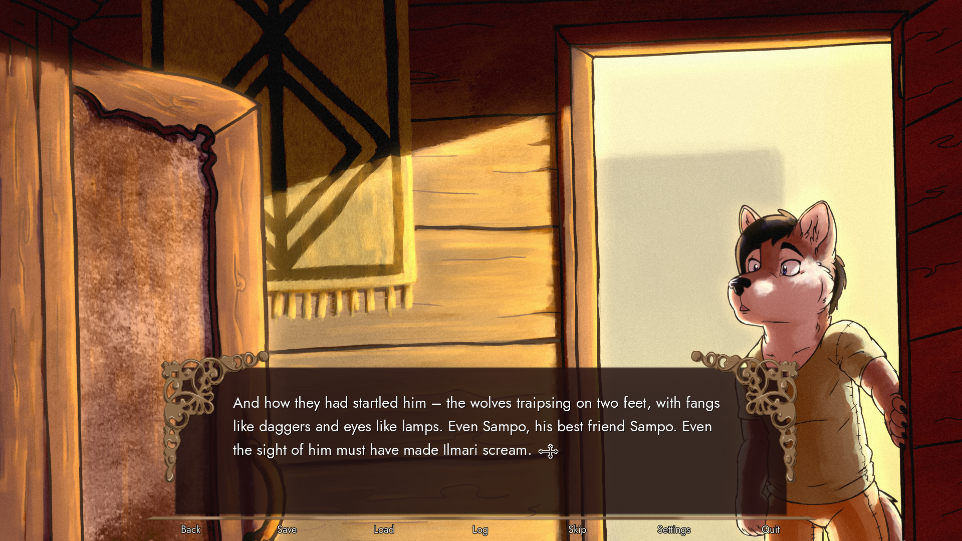
PURKKA: The opening line quotes the Juice Leskinen song Musta aurinko nousee. I tried like a million different ways to translate it, but I'm still not super happy with the current version; I guess it's just one of those things that the Finnish language can express more succinctly.
The track in the beginning is a Pink original, and in my opinion, a really good one. They did an excellent job despite it being pretty different from all the darker and more ambient tracks much of the OST consists of.
On the whole, Part 1 is concerned with establishing the rules of the secondary world, and – since this is the most time we spend there – setting up some interesting contrasts with the real world. NVL mode dominates, the backgrounds are heavily edited CC photos, and the structure is jumpy and disjointed to convey Ilmari's alienation from the life he has in the human world. In North-of-Moon, he has a sense of direction and purpose by the virtue of the fantasy quest he's imagining; in reality, we only get fragments that don't really depict him as someone who knows what he wants and what he's doing with his life.
There is a scene in the middle where we briefly shift to fantasy; I had vague plans to juxtapose all real-life scenes with ones set in North-of-Moon, but I discarded the idea to keep the pacing as fast as I could. I also think it's already pretty obvious what each bit is saying in terms of character psychology. The one I did keep felt essential enough to stay, since it's foreshadowing some stuff that gets brought back in Part 3.
In my opinion, one of the most interesting absences is Ilmari's mother – though we understand the fantasy quest revolving around recovering the lost queen as some kind of way for Ilmari to process the fact that she's not around, we don't really learn what happened to her. She's a ghost character without individuality or agency, reduced to a mere symbol. The fact that Ilmari's imagination seems to sideline and instrumentalize women in this way is a recurring theme. (I guess this is another thing that sets the text in conversation with the Narnia books, which are pretty heavy with gender roles. I love being a girl and visiting a fantastical world where I get to enjoy adventures such as doing the fucking dishes...)
While I must confess that I'm no expert on Laestadianism, I did my best to include some references to the beliefs and customs, like Ilmari's unfamiliarity with TV and worldly music (both of which Conservative Laestadians generally avoid). The later parts, meanwhile, riff on topics like confession, mercy, and suffering that are very important in Laestadian theology. One somewhat subtle detail is that Ilmari's father doesn't seem to be that much of a hardline believer (in particular, it's mentioned in Part 3 that he drinks alcohol in secret), which paints Ilmari's reactionary anxieties about the secularization of Finland in a different light.
The final line of the final scene, where Ilmari admits he considers his birthday party in North-of-Moon to be the "real" one, is maybe the most crucial of all. The big development seen throughout Part 1 is that as Ilmari matures, his fantasy world of childlike moral simplicity represents an increasingly important escape from the complexities of adult life.
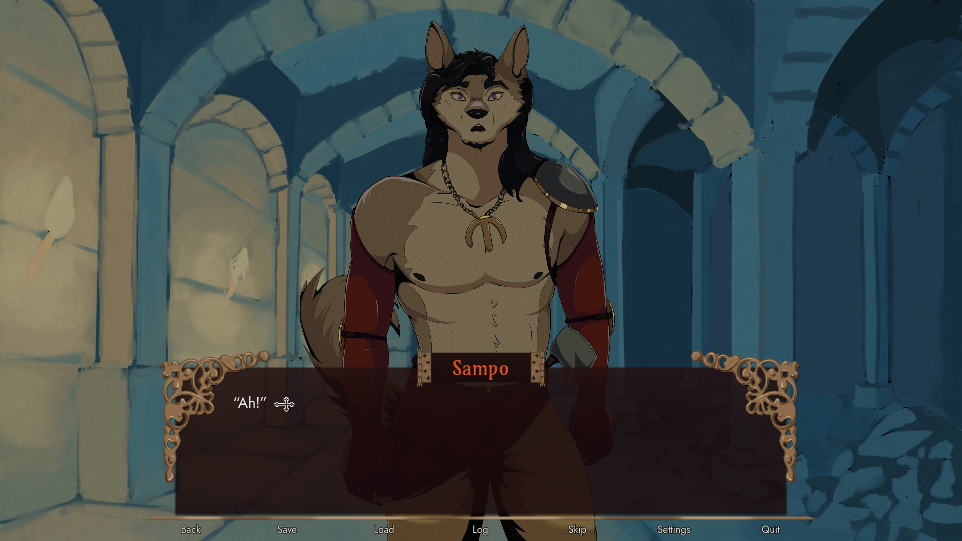
PURKKA: Part 2 starts with some scenes that establish the basics about adventures Ilmari and Sampo go on. There's a lot of fakey videogame nonsense – the demon fight is entirely pretend drama on Ilmari's part, since he's immortal – that I think feels sort of unnerving just in the sense of what it says about the extent of Ilmari's influence on this world. Based on him being depicted as a gamer in Part 1, we can guess it's his fault things are like this, but the inhabitants of North-of-Moon seem largely unconcerned with the fact that they live in World of Warcraft now. This tension, which is left largely understated, is pretty compelling to me.
There's obviously a lot of character stuff going on as well. The defining aspect of Ilmari's and Sampo's dynamic, and why the text foregrounds the fact that people have mirror images in the fantasy world so heavily in the beginning, is Sampo acting as a wish-fulfillment projection of Ilmari's repressed desires. He is quite a bit more sexually open, sort of cockier and more confident in personality, and maybe most importantly, the quest is all real to him; he is in actual danger, and as far as he knows, taking productive steps towards recovering his lost mother. You kind of get the sense that Ilmari isn't even necessarily the main character of his fantasies – he's just living them through Sampo. Ilmari's repeated concerns about Sampo's safety come off as more of an absolution of guilt, since the wolf is his North-of-Moon counterpart and is (in a sense) expressing his thoughts while insisting on being involved.
Anyway, I think Kachayet did a really good job at layering different influences in the backgrounds for this part while maintaining a cohesive aesthetic overall. The demon's lair feels so distinct from the village; you can tell they represent different things Ilmari has been inspired by.
I personally love the delicious hypocrisy of Ilmari being hesitant about messing around with the wardrobe. What is any of this, if not that? Person who utilizes a magical portal to another world like every day mostly for his own amusement: let's be careful with the magical portal...
The mystery-sickness-cum-impromptu-surgery scene represents a sudden shift in genre & tone that reconfigures the entire story in a way it never recovers from. Most of the darker implications of the narrative and the world presented through it have remained subtextual, but here we just go for it and never look back. The episode itself is, first of all, not very subtle as a metaphorical sex scene; you don't need to fetch your reading glasses to catch the penetration imagery. Along with what follows, it's playing in a hurt & comfort fanfic space, and fittingly, both of those have the same origin: Ilmari (whose influence on the world is the only explanation provided for how the shard could have gotten into Sampo).
There's a lot of stuff with sprite blocking and effects that I'm very proud of here; I think it's a very dynamic scene for sticking firmly to a sprites-only presentation. Also, I find it funny how Pink had to draw additional pained expressions for Sampo after the initial set they did before reading the script. I guess my original pitch undersold how much of this story involves torturing that poor wolf...
Ilmari's rejection of Sampo's advances is a moment some readers had a pretty strong reaction to. I think it can be a bit surprising since it's common for FVN protagonists to be, if not a literal blank slates for the purpose of self-insertion, then at least characters whose interiority we can access transparently and who rarely do anything that disagreeable. Over here, though, we're put in the head of someone who's sort of a contradictory person haunted by denial and repression and who – in threatening to expose and blame Sampo – commits an unambiguously evil and cowardly act. It's a dark, dark moment, and one of the worst in terms of Ilmari callously using the people in his fantasy world to work through his own issues.
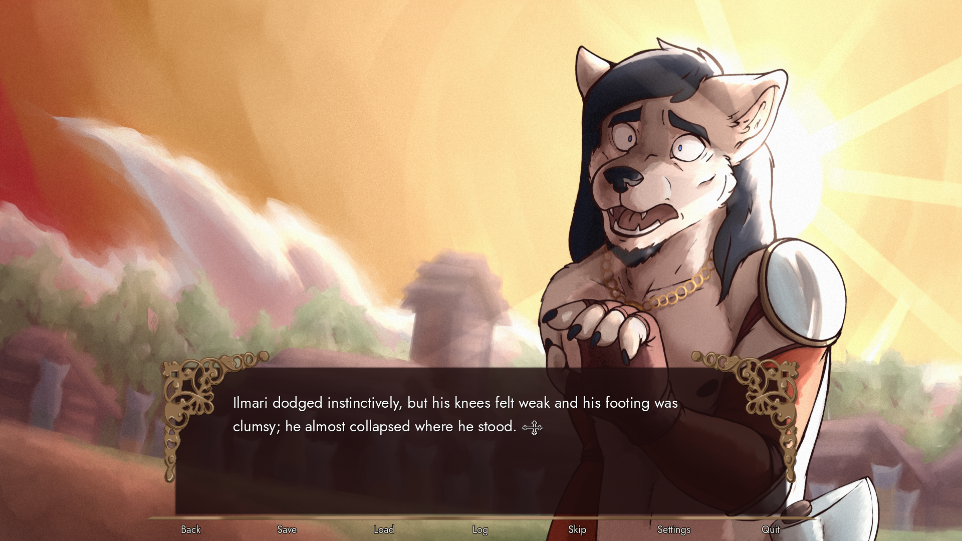
PURKKA: Drake really did an amazing job with the CG here; the use of colors and lighting adds so much drama, and I like what I did with animating the shot, too. I think it feels as impactful as it should for the arguable key scene in the game.
Also, believe it or not, I only noticed the extremely obvious Biblical allusions in casting stones after writing Part 2. The least subtle references are always the ones you didn't even intend to make...
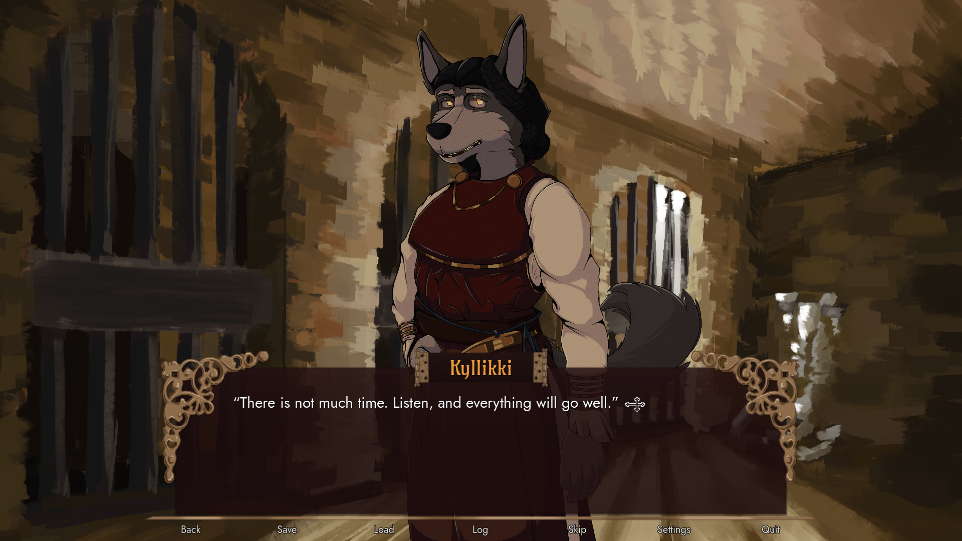
PURKKA: Kyllikki has a small but important role in the game. On one hand, she basically shows up as a video game NPC designed to help Ilmari through this part of his journey; on the other, you can tell she might have her own schemes going on. It does not feel like an accident that her plan would have forced Ilmari to flee North-of-Moon. In this sense, cracks are starting to show up in Ilmari's control of this world as he becomes more conscious of what he's doing and has to decide whether to continue or not. There is also a lot of setup for the final scenes; Ilmari's confession here will be mirrored later on in a very significant way.
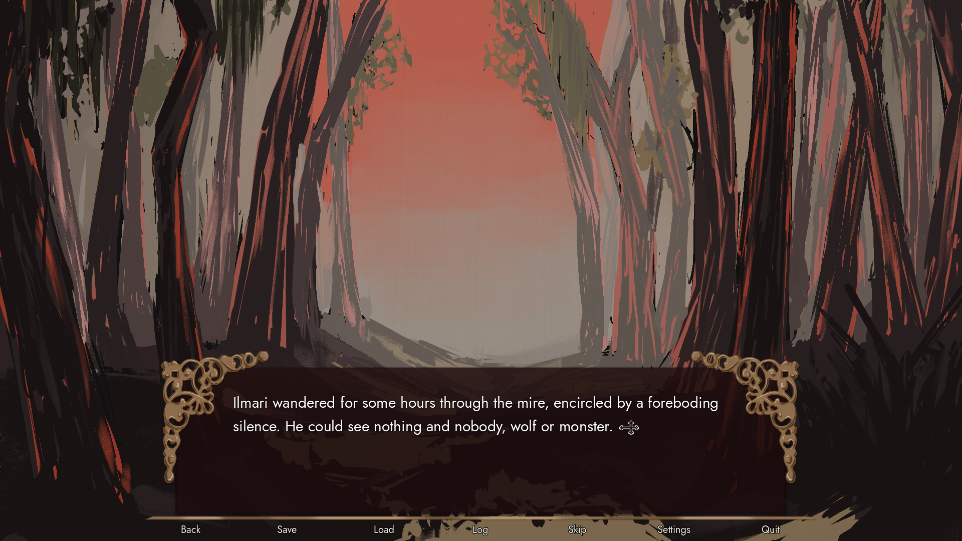
PURKKA: The mire's name in Finnish ("Sysiräme") is a double pun that unfortunately didn't translate at all. "Sysi" is an archaic word for coal, but how it's used here also recalls "sysimetsä" ("deep/dark part of forest"), where it has a more metaphorical meaning. And: "sysi" is very similar to "susi", or "wolf". Please DM if you can think of an English translation that incorporates all of this, I've got nothing.
The charred forest from Mata Nui Online Game acted as a reference for the background. The vaguely Alien-esque monster evokes the feeling that the evil corruption might represent Ilmari's repressed sexuality; it's an amazing detail in Drake's CG that the monster's claw can also be read as its penis.
As for the battle scene itself, it's similarly supposed to feel sort of brief and weightless in the sense of Ilmari only wanting to imagine that fighting a creature is where the stakes of this story lie. Sampo's tragic end via mushroom made deadly by means of a warning Ilmari received from his father is an image that implicates both of them; at the risk of being self-congratulatory, I think it's a good detail.
It took some feedback from the team and some revisions to make the scene where Ilmari buries Sampo work. By this point, Ilmari's culpability in how events transpired is obvious, and I wanted that to poison the tragedy in a way; as a work of horror, the game is not just about bad and horrifying things happening but also about tapping into anxieties about how our own actions and problems can end up harming other people.
I don't know how well I was able to convey it, but I wanted the cliffs to represent the mysterious end of Ilmari's world like the border of video game level, or I guess a player-made Minecraft map where you walk out of bounds and normal terrain starts to generate. The vibe is that Ilmari's actions have derailed the story he was imagining beyond repair, and he must now both decide what to do next and confront some uncomfortable truths about why and how he made it happen in the first place.
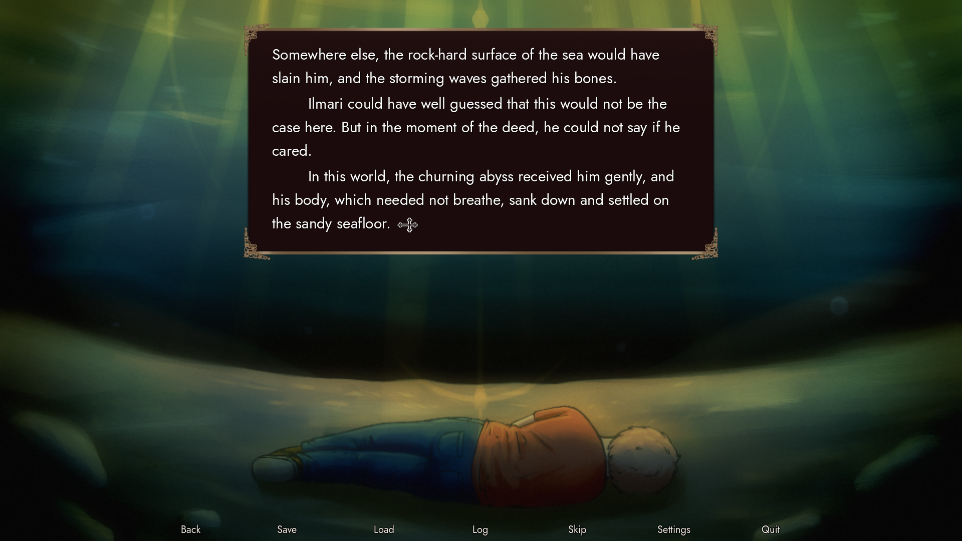
PURKKA: This CG references a shot from Hong Sang-soo's On the Beach at Night Alone. I love the combo of Drake's art and Pink's music here; I think the atmosphere reflects the layered emotions in the scene well.
Before Ilmari's story ends, we get a short cutaway to Marjatta, Kyllikki's mother. This was another scene it took many iterations to get right.
Let's unpack the quite unsubtle mythological reference first: Marjatta is the woman who gives birth to Jesus in the end of the Kalevala. Here, this element is repurposed in a more sinister light and made into a reflection of the choice Ilmari has to make once he becomes aware of (or stops being in denial about) the full extent of his influence on North-of-Moon. The birth of the "Coming Savior" would represent Ilmari consciously taking control and forcing his will and his religion on the land; though the final line is ambiguous, we may assume what happens is the opposite. (One thing that links the apocalyptic visions to Ilmari directly is wolven society being depicted as being or becoming half sinful, mirroring his fears about 50 % of Finland leaving the church.)
Incidentally, birth control and abortion continue to be big issues in Laestadian circles, and there is some drama related to that going on literally right now. I guess it's pretty obvious what this story is gesturing at with the whole aborting Baby Jesus thing.
Another function of this scene is to represent the will and the agency of the wolves finally, if briefly, breaking through as Ilmari grows more comfortable with the idea of letting go and North-of-Mooners slowly stop playing along. Importantly, though, the religious conflict happening in the village still reflects Ilmari's inner turmoil – his influence is weakening but changing shape instead of disappearing entirely.
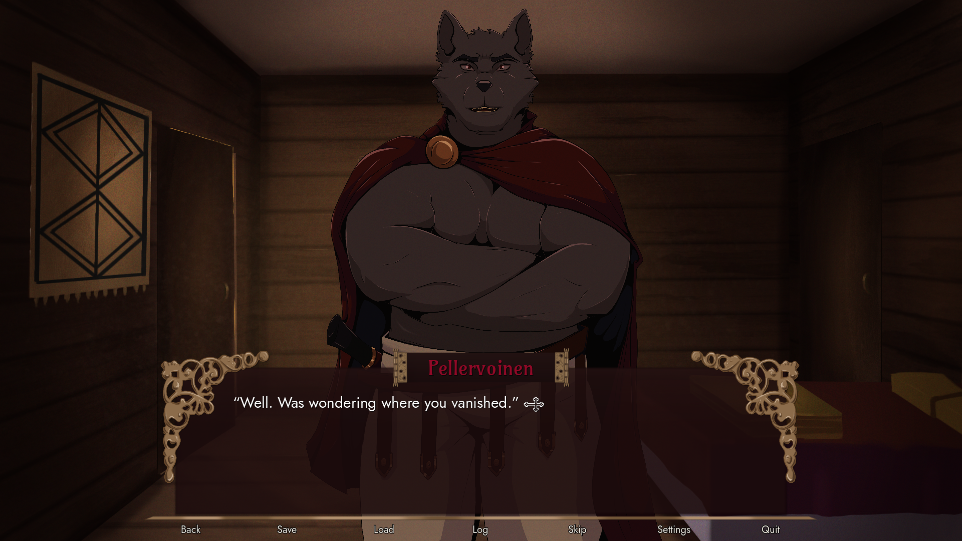
PURKKA: Indeed, a key line in the next scene notes that Ilmari will never be able to see his world in a way that's separable from the control he exerts over it. The only hope is for him to leave permanently, and even then, what ultimately happens to North-of-Moon and whether things can ever go "back to normal" remains a mystery.
The character drama reflects this in a pretty juicy way (at least in my opinion) in how Ilmari's meeting with Pellervoinen is a metaphorical confrontation with his father and the fact that this is a subjective framing he can't help but impose on the situation. I also find it funny how both characters blame each other for Sampo's death while minimizing their own role.
Anyway, Pellervoinen saying he could attempt to build a new wife out of gold is a shameless author appeal reference to one of Kalevala's strangest episodes, where Ilmarinen does it and there's a moral about how sex with robots is bad. I guess it's not a completely meaningless allusion, since it is another angle (besides the creation of Sampo) to approach Ilmari's relationship with North-of-Moon and its inhabitants through.
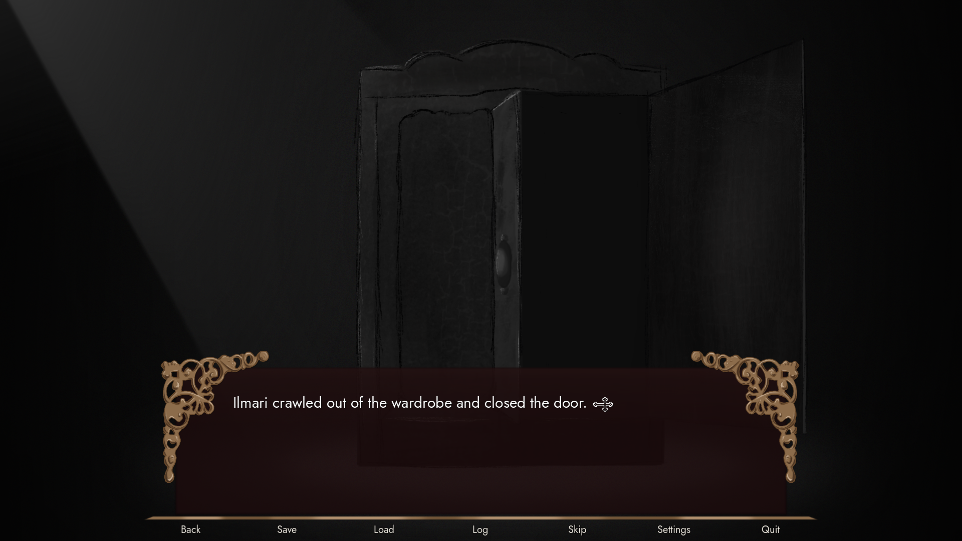
PURKKA: Part 3 ends in a sort of overtly satisfying way with the visual callback to the wardrobe closing and Ilmari's commitment to self-improvement, but there's still the epilogue to go, and it dampens the mood a little.
The real-world contexts of the Christianization of Finland and the writing of the Kalevala really come into focus here after lingering in the background for much of the story. After converting the village to his religion, Ilmari ultimately finds something valuable in its old stories and traditions – but only through appropriating the traumatic events he was responsible for into the creation of a highly marketable YA book series. It is not a particularly subtle allusion to Elias Lönnrot compiling the Kalevala out of the myths of the Karelian people in order to forge a national mythology that would allow Finland to constitute a proper nation-state.
And yet, Lönnrot's relationship with the material is sort of ambivalent and sincere in a way that prevents his work from reading as mere propaganda; Kalevala received criticism upon publication for not being fully in line with the traditions of European epic poetry. Ilmari has similarly complicated thoughts about what he's doing – he does admit he might be appropriating a story he has no right to tell, but also seems proud of his creation, and the cycle of transgression and confession is ultimately just too addicting. It is no coincidence that the interview recalls the scene with Kyllikki, most prominently with Ilmari imagining Sampo as he did there. Though the other world might be free of his influence, Ilmari himself is still trapped within what he created.
That's about it, I think! Hope all this felt like interesting context for the story whether your prior reading of it was similar at all or not. Now, let's hear what the team's artists have say about their parts.
PINK: Hello! You’ve gotten through that expansive and interesting read from purkka. And now, you’ve gotten to Pink’s little corner - a section on the process of character designs, and giving nuance to the game’s identity through music composition.
(Any opinions or reflections in this section are my own and do not represent the team’s)
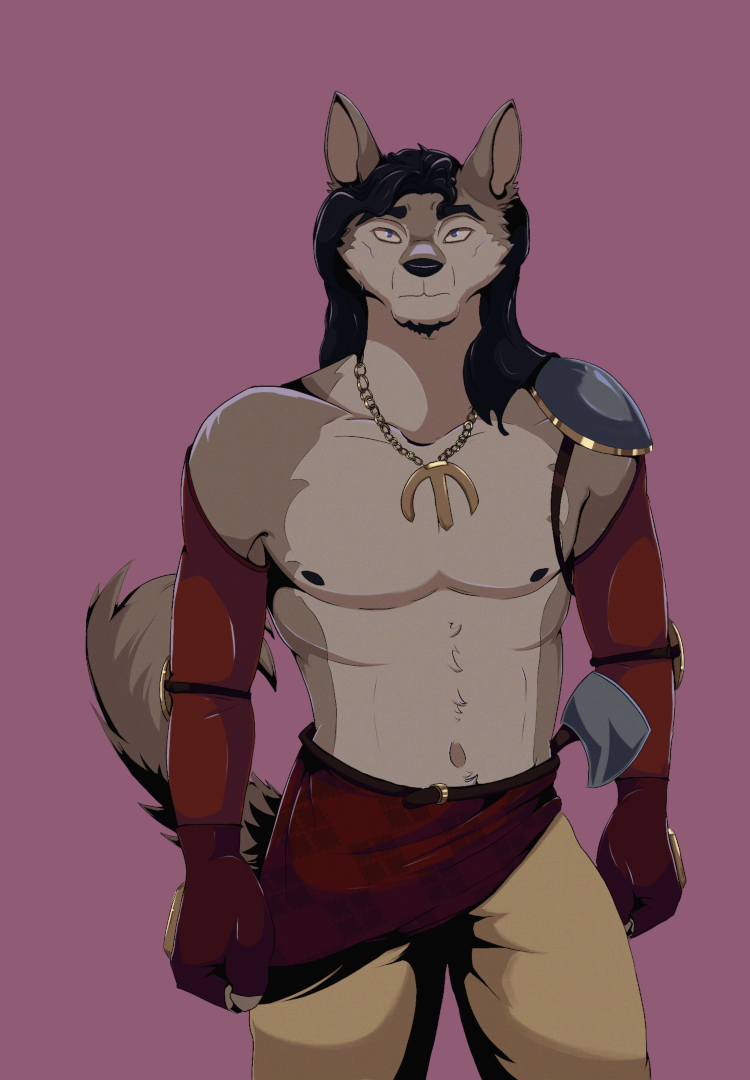
PINK: Sampo is Ilmari’s “My Wolf” (for the uninitiated, a My Wolf refers to the trope of furry visual novels with a wolf love interest). Of course, depending on interpretations of the story, he is a true manifestation of this trope; a wolf created by Ilmari to be his own closest friend and an object of repressed sexual desire. Sampo is designed by Drake, with some smaller alterations by me while making the sprites for visual cohesion - notably more golden accents. We went with an asymmetrical design to his outfit to give it a flowing shape, drawing the eye between key elements of the character. The long hair lends a softer and more feminine characteristic to him when compared to many love interests in MLM-focused stories.
His light armour is made for ease of movement in a fight, with a bare torso. This lack of covering up represents several things to me. His trust in Ilmari to keep him from harm is absolute; reflects Ilmari’s struggle with sexual desire, serving as both what Ilmari wants and as a constant temptation to give in; Sampo is vulnerable and exposed in his relationship with Ilmari, who has all of the power here.

PINK: Kyllikki is the parallel to Ilmari’s friend in the real world. In North-of-Moon she is sidelined to a named background character, only showing up in Ilmari’s hour of need. This can be interpreted as Ilmari not putting much value in their real friendship, and a degree of misogyny he brings to North-of-Moon coming with his religious beliefs. It also reflects a different type of misogyny present in the genre this game is based on (gay furry isekais, and perhaps even FVNs as a whole), where female characters often get small roles like “friend who is supportive to the MC”. If women are present at all, in cases of the media being so gay it forgot about women existing.
For her design, I referenced images and art of old Finnish ways of dress. She wears many layers of long clothing, protecting the body while having cuts in the right places to allow for mobility when doing work in the village. A common element in the references was women keeping a dagger with them, which I felt was important to include. Kyllikki, like Kylli in the real world, is not afraid to speak up when she doesn’t approve of things (especially Ilmari’s bullshit). In her design, this is shown by being armed, a confident posture, and particularly disapproving expressions. As a final note on this character, she is the only one I gave the glow of the eyes to (my artist signature quirk). It’s a nod to how she sees through Ilmari’s illusions more than anyone in North-of-Moon.
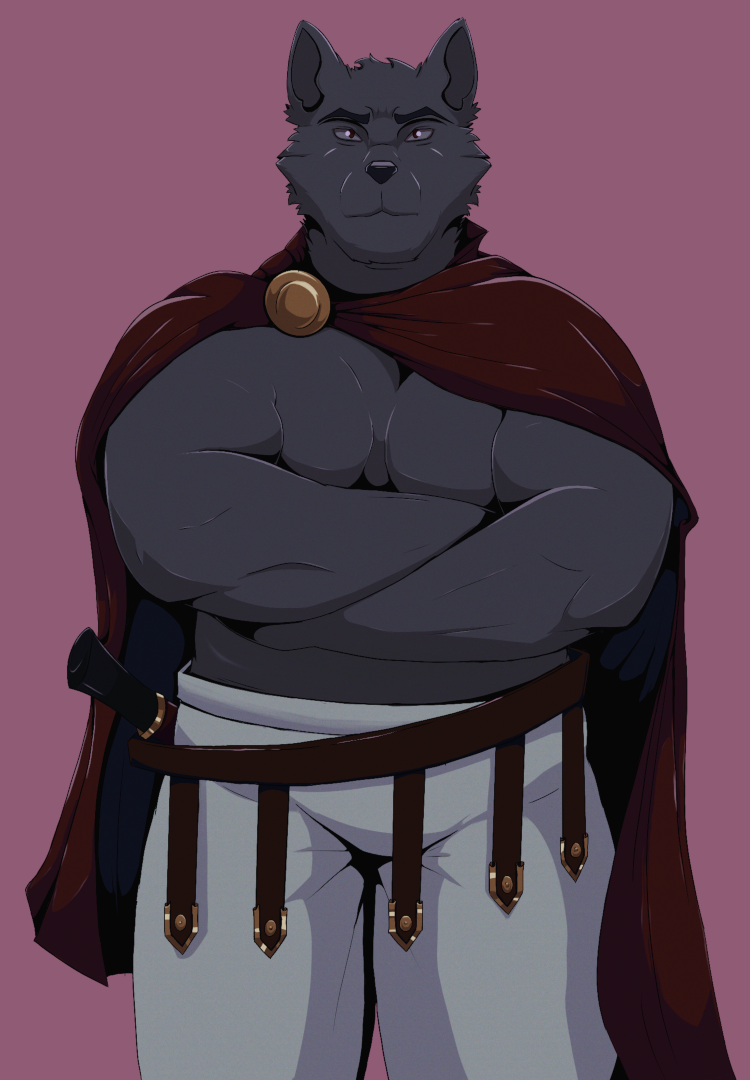
PINK: Pellervoinen is Sampo’s father, and the parallel to Ilmari’s father in the real world. As the chief of the village, he is the epitome of Ilmari’s perspective on authority; masculine, huge, and austere no matter what. It is also difficult to ignore that he’s hot, and perhaps hot in the way more typical for “My Wolves” than Sampo himself. The first reason for this is simple: Clicks and Views! Marketable bara wolf tiddies are a true and tested way to pique the interest to check the game out. The second reason for this design choice on my side has to do with furry escapist fiction. The fact that a father figure is really hot for some reason is congruent with trends seen in these stories. Finally, Pellervoinen’s masculinity and stature seemingly cut out of stone are in direct contrast with Sampo’s subtle feminine visual traits and the flow of his posture.
The design of Pellervoinen is perhaps the most simple of the sprites. Referencing attire of old Finnish kings and chiefs, he only wears pants (with a modest bulge), chunky belt, a cape barely hanging onto his body, and a sword. While Sampo’s face shape is angular, Pellervoinen’s is much more rectangular. After showing a WIP to a friend, who would declare themselves an expert on Dads, lines were added under the eyes to make him look older and haggard. The posture is self-explanatory - he demands compliance with a reminder of the physical power he possesses, if the power of village chieftain isn’t enough.

PINK: The UI was also made to be cohesive with the aesthetic of the characters, keeping to a red base with golden accents. While I made most of the UI assets, purkka elevated them through coding magic and creativity to utilize everything to in ways I would never have thought of. The actual inspiration for the golden accents were parts of ostentatious bibles.
The music received an equal amount of effort as the art from me. Hallowed be the name of Kevin MacLeod and what he has done for indie games, but forming an auditory identity to a piece of art using only creative commons music would be a very difficult task. I’d say my contributions to our original soundtrack paid off. The general throughline for the composition of the music was to create an artificial fairytale which is barely keeping together. In many of the tracks, one can hear cassettes stopping or rewinding, with harmonic dissonance used at times as if the music itself is confused as to what emotions it’s supposed to convey.
PINK: Fraught Wardrobe, the main menu track, greets the player with bemoaning viola, distorted keys like a child’s broken plastic piano, and guttural ambient bass. It has been described as both “evil” by some, yet “calming” by others.
PINK: Tell Me I Want is the track playing during the intimate scene between Ilmari and Sampo. It went through a lot of iterations, as I was unable to play through the actual scene when starting; it never matched purkka’s vision, and so I pushed back a final attempt until the scene was translated. It clicked what was wrong with previous attempts when I finally had it before me. This is the moment the fairytale is torn apart. It’s the moment Sampo’s love and devotion for Ilmari is torn apart. And it’s where Ilmari’s love for Sampo is exposed as conditional, artificial and self-serving. So this song is just that: a love song, with no love to be found. It also plays in the final scene of North-of-Moon, during Ilmari’s and Pellervoinen’s confrontation in Sampo’s bedroom, adding another layer to the scene by calling back to Ilmari’s and Sampo’s last true moment.
PINK: Gelid Gold is the final song to highlight, which plays when Ilmari is lying on the bottom of the sea. The sound of water is actually part of the track itself, ebbing and flowing in volume with the flute and violin. The character of the track is greatly inspired by Drake’s CG. We’re alone at the bottom of the ocean, embraced only by a cold bright light, which I wanted the music to feel like to the listener.
DRAKE: Hi! Drake here, I drew the CG’s for this VN as well as designed the main wolf, Sampo.
For the CG’s, I wanted to utilize my skills of using the rendering to give a certain atmosphere and give them a dramatic effect as is usually notable in my work. I like using stark contrasts and use color creatively in rendering as well as casting shadows on objects in unique ways, all of which create a strong atmosphere and can change the way you view the whole artwork. One other way I add dramatism is using angles and distorting the perspective, which lessens the stiffness which in turn lets the surreal feel let emotions affect more strongly.
Although I mostly developed the style on the CG’s on my own, I did use the finnish painter Akseli Gallen-Kallela for inspiration, mostly his Kalevala collection. I mainly derived his usage of ‘’lineart’’ on some of his paintings and flat shading that I assimilated on my own style for the CG’s.
The combination of my way of rendering, the way I use angles and inspiration from Gallen-Kallela is a style which is reminiscent of Kalevala and finnish mythology, which is still distinctly my own and which accentuates the emotional impact of the scenes they convey. Although I didn’t have that much time to work on these CG’s and I would have polished them a bit further, I’m still very happy with how they turned out.
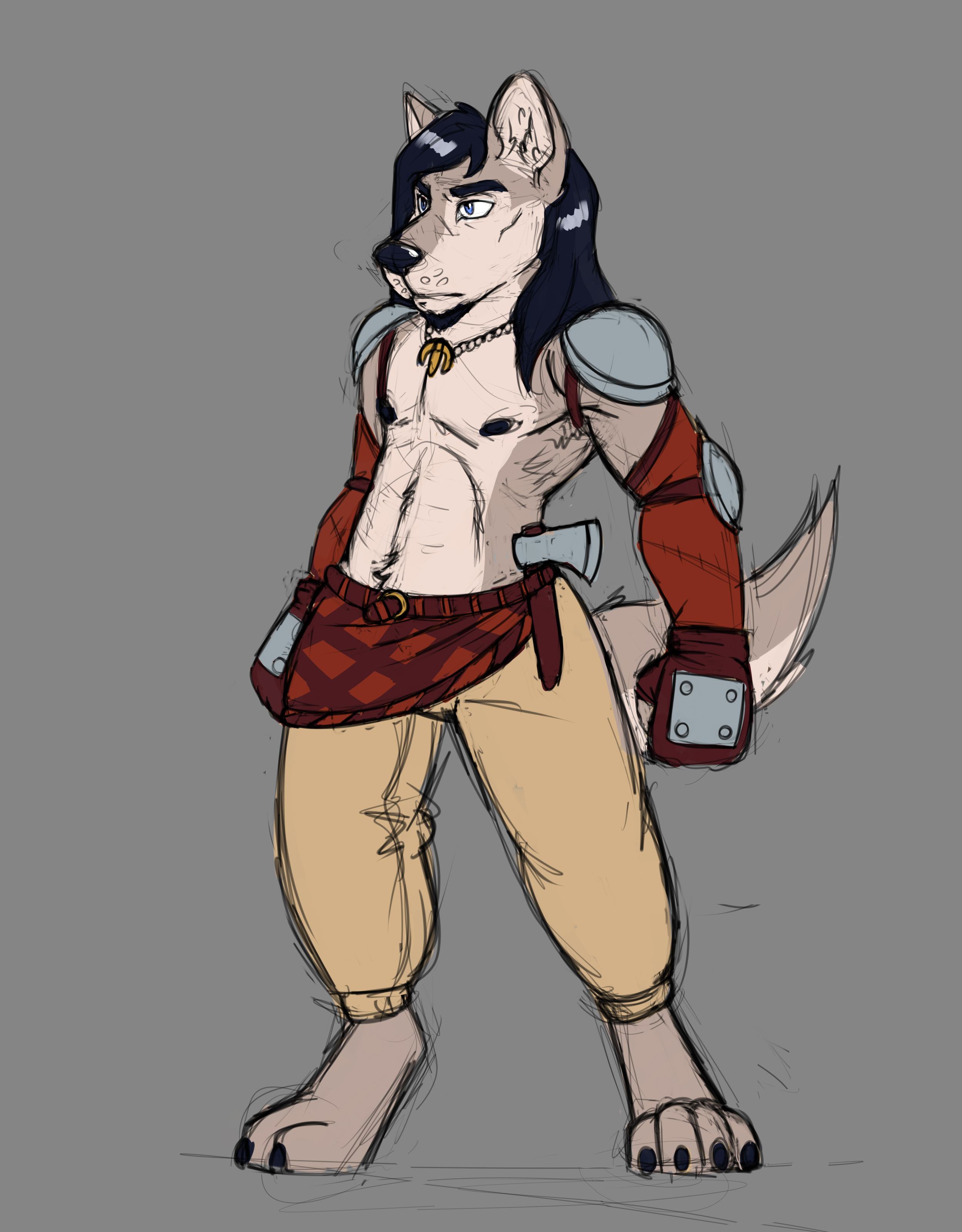
DRAKE: For the main wolf Sampo, I wanted to design a main wolf love interest that wasn’t visually as conventional as other main wolves in furry visual novels. As Pink mentioned, I gave him longer hair for a softer, more feminine characteristic opposed to a more masculine wolf-characters one might typically see more frequently. His body type is also the opposite of a buff wolf with large muscles and a big stomach; it is smaller and skinnier. His hair as well as his early design was also inspired by the painting ‘Kullervo Cursing’ By Akseli Gallen-Kallela, along with the white tan colored pants and a belt with a weapon on it. I also used ancient finnish clothing from the iron age as inspiration, mainly for the color scheme with dark brown and reds and small golden highlights from jewels.
KACHAYET: Hello, this is Kacha, the main background artist responsible for the forest, village, dungeon, swamp and demon lair’s artwork. Although I started out being inspired by Gallen-Kallela, while painting the forest I found that Werner Holmberg and other similar romantic landscape artists would be more fitting both aesthetically and thematically. However, for the village, I was also inspired by Vasily Polenov and (specially) Alexander Alexandrovsky’s several paintings of Russian villages as reference for a rural landscape.
On the other hand, the indoor areas such as the dungeon and the demon lair were based on photo references available online.
As you can see in the speedpaints, at first, I tried using a grey scale to save time with the forest and village backgrounds, seeing that they would both need alternative versions for different times of the day. But the colors that I managed to get using it didn't appease me, so I colored by hand normally then used different effect layers to get alternative versions.
PURKKA: This concludes our developer commentary. Thanks for reading!
Get The Wolf in the Wardrobe
The Wolf in the Wardrobe
When the spirit is strong...
| Status | Released |
| Authors | purkka, Kachayet, Pink Narcissus, Y0ku_Drake |
| Genre | Visual Novel |
| Tags | Bara, Fantasy, finland, Furry, Gay, Godot, Horror, Narrative, Queer, Short |
| Languages | English, Finnish |
| Accessibility | Color-blind friendly, Subtitles |
More posts
- Our game got delisted (not clickbait)1 day ago
- Post-jam vibes + polish update coming16 days ago
- The Wolf in the Wardrobe - Soundtrack Now Available on Bandcamp!45 days ago
- Initial release56 days ago

Comments
Log in with itch.io to leave a comment.
I felt, at the end, in the scenes before he leaves for the last time, Ilmari could have thought a little more about his relationship to the world - as Kyllikki was saying, he made all the bad things happen just to end them again, but never entirely - and give Sampos father a scroll with a "spell", something like this writing: "If this scroll is torn, all of Ilmaris' fantasies will be unmade - reverting the world back to 10 years ago or whatever.", with the note to only do that after he left through the wardrobe, and that Ilmari doesn't know if it would work or if the father would really want to do such an extreme thing to the world, but the option might be there if he so chooses.
Because Ilmari essentially doomed the world to ruin by leaving and not defeating the demons he made, he could at least gift himself and sampos father a little bit of hope before fucking off.
He is responsible. And he knows that. He just figured that out in a hard way. But he basically says, "yeah, now it's your problem. k thx bye" and just floops out of there like he doesn't give a damn.